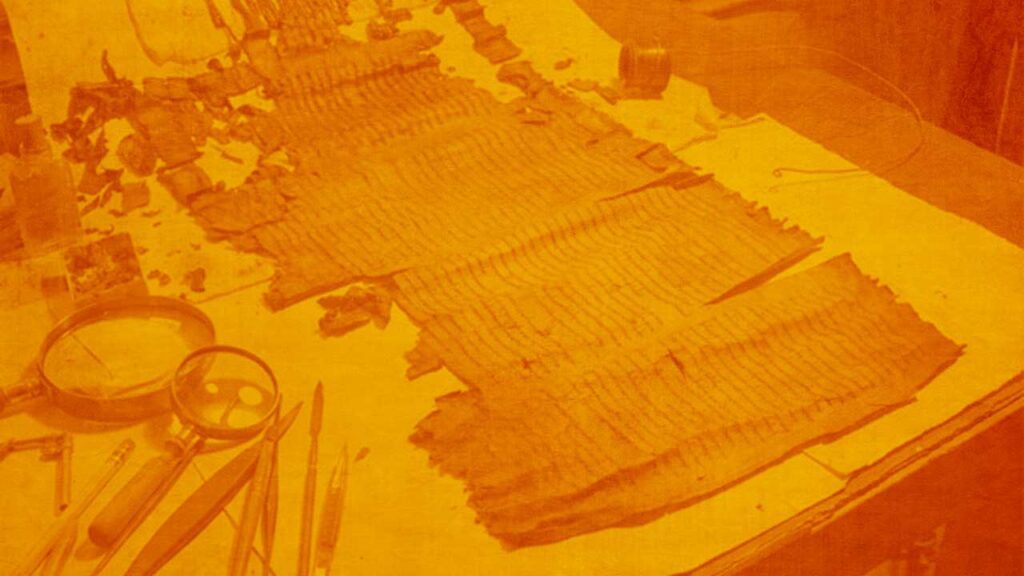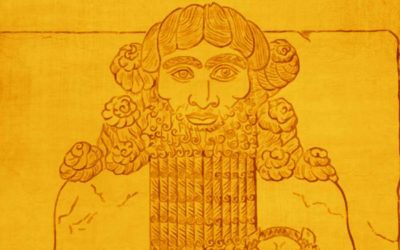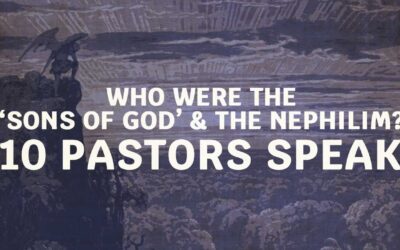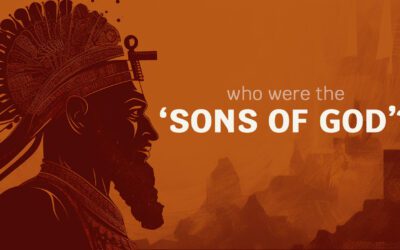One of the original seven Dead Sea scrolls found by shepherds in 1947, the Genesis Apocryphon is also known as the “Tales of the Patriarchs” or the “Apocalypse of Lamech”.
This book extrapolates on the stories found in Genesis, the Book of Jubilees and 1 Enoch. It is generally believed to have been composed between the 3rd and 1st century BC. Some sections are highly fragmented and missing.

Below are two sections from the book that parallel the story of Genesis 6:1-4. Lamech (Noah’s father) wonders if his new son is really his, or is the son of an angel. His wife swears that the child is not from a Watcher, but is truly Lamech’s.
The second section is when a Watcher delivers a message to Noah, instructing him about the fate of the Nephilim and acknowledging Noah’s singular righteousness.
Quote(s)
Then I considered whether the pregnancy was due to the Watchers and Holy Ones, or (should be ascribed) to the Nephil[im], and I grew perturbed about this child. vacat
Then I, Lamech, became afraid and went to Batenosh, [my] w[ife … saying, “Dec]lare [to me] by the Most High, by the Lord of Greatness, by the E[ternal] King [whether the child comes from the] heavenly beings! Everything will you truthfully tell me, whether [ … … ] you will tell me without lies: is this [ … … swear] by the Eternal King until you speak truthfully to me and not with lies [ … ].” Then Batenosh my wife spoke with me forcefully. [She we]pt and said, “O my brother and master, recall for yourself my pregnancy [ … … ] marital relations, and my breath within its sheath (?). (Can) I truthfully [tell you] everything?” [ … … ] then I was perturbed even more. vacat
When Batenosh my wife noticed that my face had changed (its) expression [ … … ] then she gained control of her emotion(s) and spoke with me. She said to me, “O my master and [brother, recall for yourself] my pregnancy. I swear to you by the Great Holy One, by the Ruler of Hea[ven] that this seed is yours, that this pregnancy is from you, that from you is the planting of [this] fruit [and that it is] not from any alien, or from any of the Watchers, or from any heavenly bein[g.
Source Translation
Another quote
great Watcher to me as a messenger with a message of the Holy One [… … … …] he spoke with me in a vision and stood before me [… … … …] message of the Great Holy One. He made me hear a voice (saying), ‘To you they say, O Noah [… …. … …] and I thought .. I had knowledge of all the behavior (?) of the inhabitants of the earth, and I declared every [… … … … …] they will prosper (?) [… … … … … …] two weeks, and then sealed (?) [… … … … …] the blood which the Nephilim shed. I was quiet and waited until [… … … … …] the Holy Ones who were with mortal women [… … … … 2 lines missing … …] But I, Noah, found favor, distinction, and righteousness [… … … … … 1 line missing …] unto the gates of heaven [… … … … …] to humans, cattle, wild animals, birds, and [… … … 1 line missing …]
Source
Further Reading:
If you’re looking to investigate this manuscript further, there is very insightful research being done on these old documents.
In this book available from Brill, The Dead Sea Genesis Apocryphon, discover a fresh transcription, translation, and detailed textual notes based on a close study of the original manuscript, available photographs, and previous publications. Explore the Apocryphon’s prominent position among the Aramaic Dead Sea Scrolls and its unique features compared to the Book of Jubilees. Gain a reliable edition of this captivating retelling of Genesis and deepen your understanding of its message.
In addition to that book, this is a dissertation on the topic “THE GENESIS APOCRYPHON (1Q20): A REEVALUATION OF ITS TEXT, INTERPRETIVE CHARACTER, AND RELATIONSHIP TO THE BOOK OF JUBILEES” by Daniel A. Machiela, B.A., M.A.
This dissertation focuses on two main aspects: the Genesis Apocryphon text and its relationship to Jubilees regarding the division of the earth among Noah’s descendants.
The introductory chapter addresses previous studies on the Genesis Apocryphon, discussing its designation as “rewritten Bible” and its connection to Genesis and the Qumran sect of Essenes. A new transcription, translation, and textual notes are provided, including corrections and new readings. The dissertation explores the background of the earth’s division, highlighting the Table of Nations, the Ionian world map, the Genesis Apocryphon’s geographic setting, and Noah’s dream-vision. The author reveals an interest in emphasizing Noah’s righteousness, his role as the divider of the earth, and the legitimacy of Arpachshad’s descendants to inhabit the Land of Canaan. Comparing the earth’s division in Jubilees and the Apocryphon, it is observed that the latter is shorter, simpler, and uses a different ordering scheme, possibly indicating an earlier account or a common cartographic source.
The dissertation proposes new toponyms for both texts. Through language analysis and comparison with Jubilees, the Apocryphon is dated to the early-mid second century B.C.E.
It is considered an apocalyptic work focusing on heavenly “mysteries” and dream interpretation, intended to be read alongside and interpret Genesis, reflecting the distinct format of scriptural interpretation during that period.






